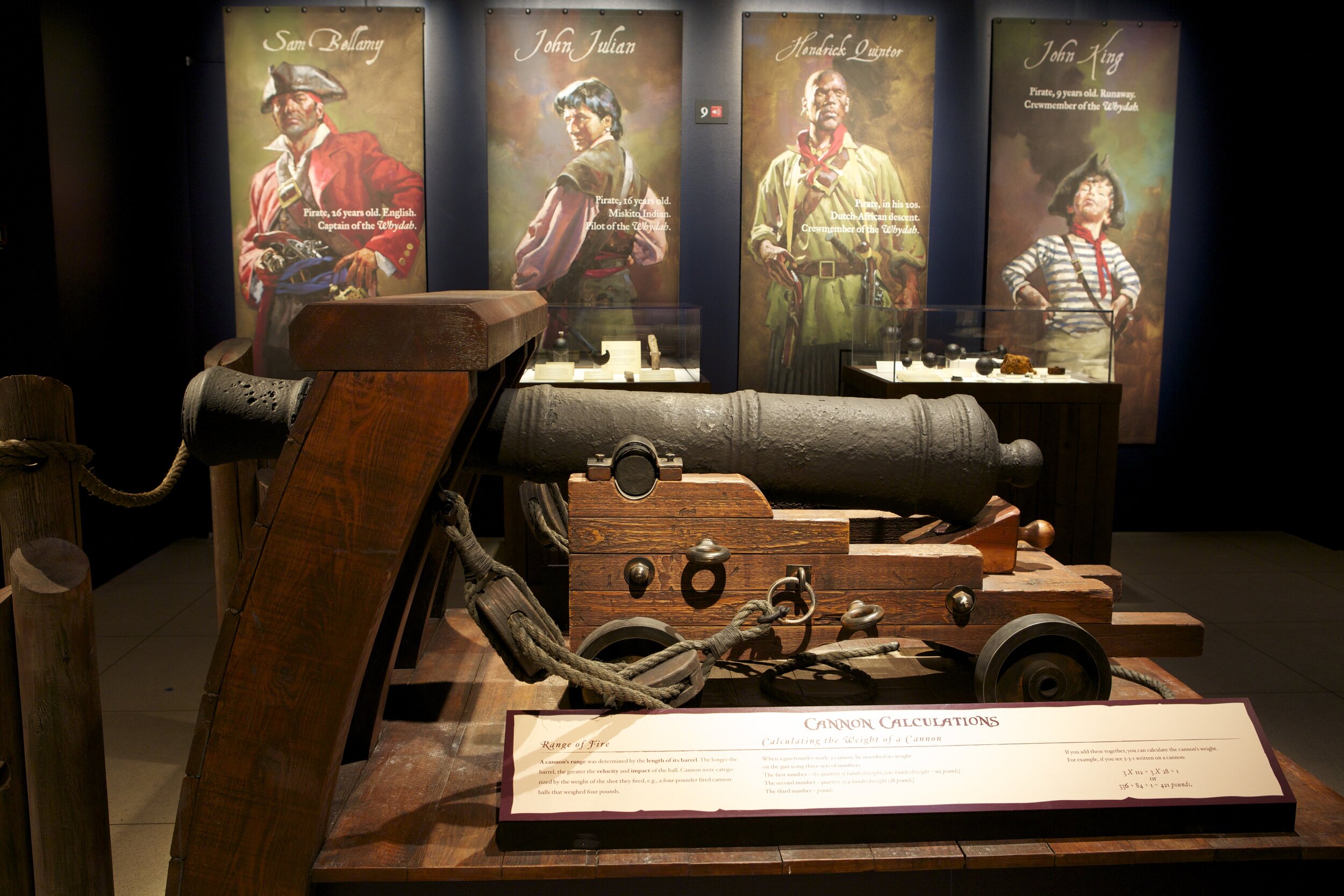The New England Foundation for the Arts (NEFA) has announced the appointment of four new members to the organization’s advisory council and the return of veteran councilors, including Knight Canney Group President, Felicia Knight.
Camp POSTCARD Celebrates 25 Years of helping Maine 5th & 6th graders enjoy a free week of summer camp
BRUNSWICK, ME. June 14, 2018 –Friday, June 15, marks the opening of Volunteers of America’s 25th year of Camp POSTCARD, a free week-long sleepover summer camp for Maine 5th and 6th graders — helping them make new friends, learn life skills, and build relationships with law enforcement.
Camp is held every year, in June, on the grounds of Agassiz Village in Poland, Maine, and is staffed by law enforcement, criminal justice professionals, and first responders who volunteer their time at Camp POSTCARD. They are joined by other community volunteers, as well as personnel from Volunteers of America Northern New England.
Real Pirates: An Exhibition from National Geographic
“This is a story of the making of America—a true story more powerful than fiction.“
– Jeffrey Bolster, UNH professor of early American and Caribbean history
PORTLAND, ME – The classical age of piracy comes to life in Maine when the Portland Science Center welcomes Real Pirates: An Exhibition from National Geographic. The 7,000-square-foot interactive exhibition showcases more than 150 artifacts, including everyday objects, personal items, and treasures, from the first fully authenticated pirate ship ever to be discovered in U.S. waters.
Real Pirates is organized by National Geographic and Exhibitions International, a leading producer of touring exhibitions.
Real Pirates tells the true story of the Whydah, a pirate ship that sank off the coast of Cape Cod 300 years ago. The exhibition features treasure chests of coins and jewelry, as well as technically advanced weaponry of the time; 18th-century cannon, pistols, and swords. These artifacts were painstakingly recovered from the ocean floor over the last 30 years and form the core of this exhibition. “This isn’t fantasy. It is the real pirates’ treasure that bears witness to this ship’s fate,” said underwater explorer Barry Clifford, who discovered the Whydah wreck.
Visitors are provided with an unprecedented glimpse into the unique economic, political, and social circumstances of the early 18th-century Caribbean. Highlighted throughout the exhibition are compelling true stories of the diverse people whose lives converged on the Whydah before its demise. Multimedia galleries showcase this period of history, including the slave trade, based in West Africa and the economic prosperity in the Caribbean. Visitors can get a sense of everyday life aboard the Whydah pirate ship, and meet Captain Sam Bellamy, one of the boldest and most successful pirates of his day. Visitors continue on the journey with Bellamy as he sails, looting dozens of ships before a violent storm sank the vessel off the coast of Cape Cod, Massachusetts on April 26, 1717.
“This unique and extraordinary exhibit defines the best of exploration,” said John Norman, of Exhibitions International. “From an archaeological perspective, we have the discovery of the shipwreck, its excavation, and the process by which it was authenticated. From a cultural perspective, we explore the rich history of the Caribbean trade routes during the 18th century and the inextricable link between the slave trade and piracy. This is the first time that this amazing story, with all of its interconnected layers and characters, will be presented in such an illustrative and educational format.”
Visitors can enter the ship as the pirates did, by ducking through a large wooden door and going “below decks” of the Whydah in a life-size replica of the ship’s stern.
Real Pirates personally relates to visitors by sharing the stories of four members of the Whydah crew, people who ended up on the same pirate ship for very different reasons, such as John King, the youngest-known pirate on board the Whydah, who was believed to be younger than 11 years old at the time of the shipwreck. King’s piracy began when the ship he was traveling on with his mother was captured by Captain Bellamy, and he joined the pirate crew despite his mother’s objections.
Whydah History
The three-masted, 300-ton Whydah was built as a slave ship in London in 1715 and embodied the most advanced ocean-going technology of her day. She was easy to maneuver, unusually fast and, heavily armed and ready for battle. She was built to transport human captives from the West Coast of Africa to the Caribbean but only made one such voyage before being captured by pirates in February 1717. Soon after the ship’s slaves were sold in the Caribbean, Bellamy captured the Whydah near the Bahamas. His crew quickly hoisted the Jolly Roger, signaling to others that the slave ship was now a pirate ship.
On April 26, 1717, the Whydah, heavy with stolen goods from more than 50 captured ships, sank during a powerful nor’easter storm off the Massachusetts coast. All but two of the 146 people on board died.
“This was a unique period in our history,” said Jeffrey Bolster, professor of early American and Caribbean history at the University of New Hampshire and member of an advisory panel composed of academic and other scholarly experts that assisted exhibition organizers. Bolster added, “Through the cache of artifacts [from the ship] we see a world generally undisclosed, one in which the Caribbean was the economic center and values were very different, an era before civil rights, before individual liberties, and before democracy was institutionalized. Without the slave trade and the wealth of the region, piracy would not have existed. This is a story of the making of America – a true story more powerful than fiction.”
***
About Exhibitions International – Founded by John Norman in 2003, Exhibitions International is the world’s preeminent museum exhibition producer. Under Norman’s direction, the company was entrusted with the most valuable treasures from earth and sea, including objects from the tomb of Tutankhamun, relics from Cleopatra’s Royal Palace, Princess Diana’s Royal Wedding Gown, and the only authenticated pirate treasure in the world. These riches are the heart and soul of breathtaking museum experiences created by Exhibitions International. Each unforgettable experience has mesmerized audiences at the finest art, science and history museums worldwide – totaling more than 30 million visitors.
About Barry Clifford – Barry Clifford is among the world’s best known underwater explorers. Born in 1945 on Cape Cod, Mass., Clifford has been involved in underwater surveys and excavations most of his adult life. Clifford is the author of four books: “The Pirate Prince,” “Expedition Whydah,” “The Lost Fleet” and “Return to Treasure Island.” He is currently working on a book about his search for the Santa Maria and his experiences in Haiti. Clifford’s work has been the subject of numerous television documentaries and features, including “Black Bellamy’s Treasure” (PBS), “Search for Pirate Gold” (Nova), “Sea-Raiders” (Turner Broadcasting), “The Hunt For Amazing Treasures” (NBC), “Lost Treasure of King Charles I” (Discovery Channel), “Sea Tales” (A&E), “Pirates of The Whydah” (National Geographic), “The Lost Fleet” (Discovery Channel/BBC-One), and “Quest For Captain Kidd” and “Quest for Columbus” (Discovery Channel). In December of 2016, it was announced that Casey Sherman, the New York Times bestselling author of The Finest Hours, acquired film rights to Clifford’s story of how he and first mate John F. Kennedy Jr. discovered and salvaged the Whydah Galley.
About the Portland Science Center
About The Gold Group (Portland Exhibitions, LLC)
Portland Science Center
68 Commercial Street – Maine Wharf – Portland, ME
Press Contact:
Jill Valley-Orlando jill@knightcanney.com
Oprah For President - A Leap Too Far
Oprah is beloved. She is passionate, holds strong convictions, breaks barriers and is a great communicator. Oprah, who has never held a public office, is suddenly mulling a run for the presidency.
Celebrity elite are now empowering people to take on government roles that they are simply not qualified to assume. Understandably our current president and his “Celebrity Apprentice” approach to his personal life and governance does tend to make one ponder that Oprah as president might indeed be an improvement.
Rage Against the Arts & Humanities…Again.
By Felicia Knight
We are living in an age of rage, perpetrated by both ends of the political spectrum, and during which, we are about to launch another battle over the National Endowment for the Arts and the National Endowment for the Humanities. Entrenched interest have trampled upon and fought over these agencies more than The Ardennes.
It’s hard to believe this nation’s cultural agencies were born from a united, bi-partisan vision; established not to solve a problem, but to help us create, expand, and care for our national patrimony. Every time a fortification of bipartisan support is built to ensure their existence, it is breached by those bent on finding a boogeyman, a fundraising mechanism, a wedge issue, or an Internet meme that can rally the crowd.


